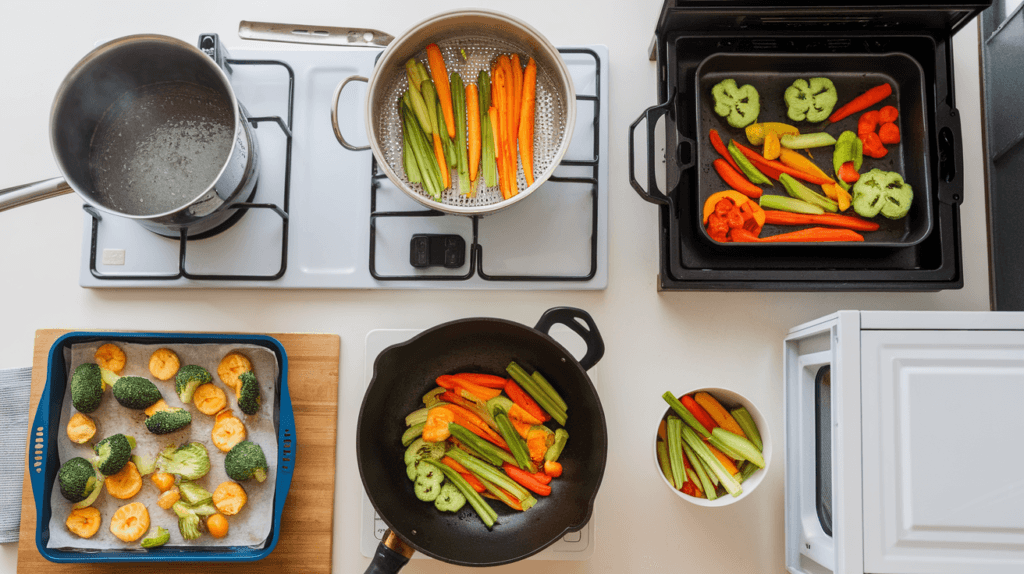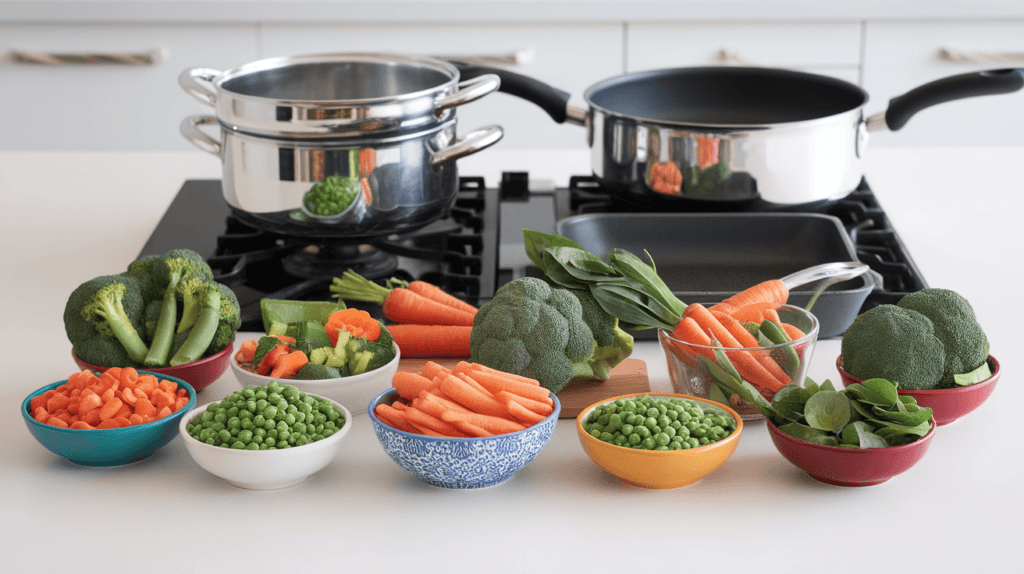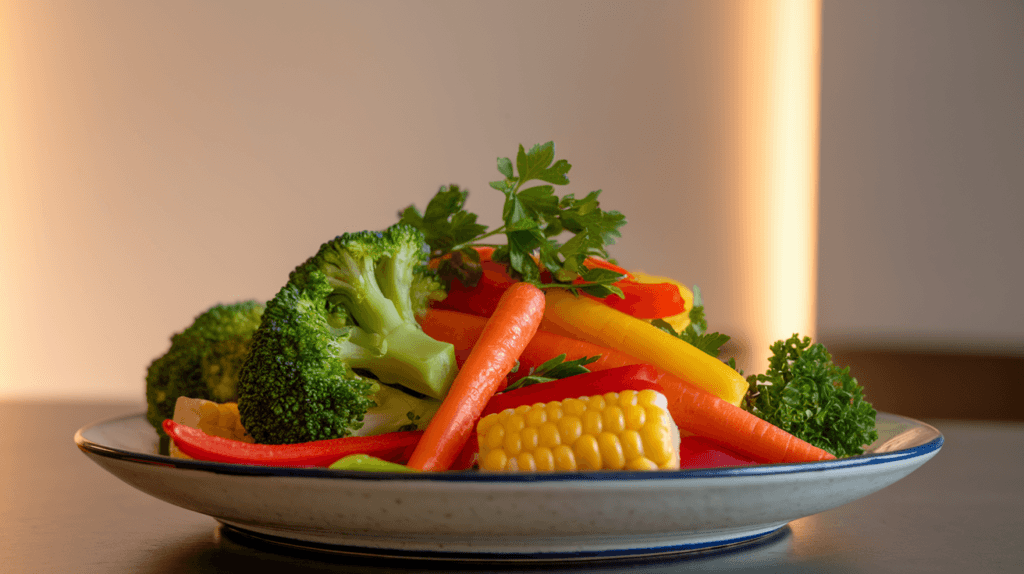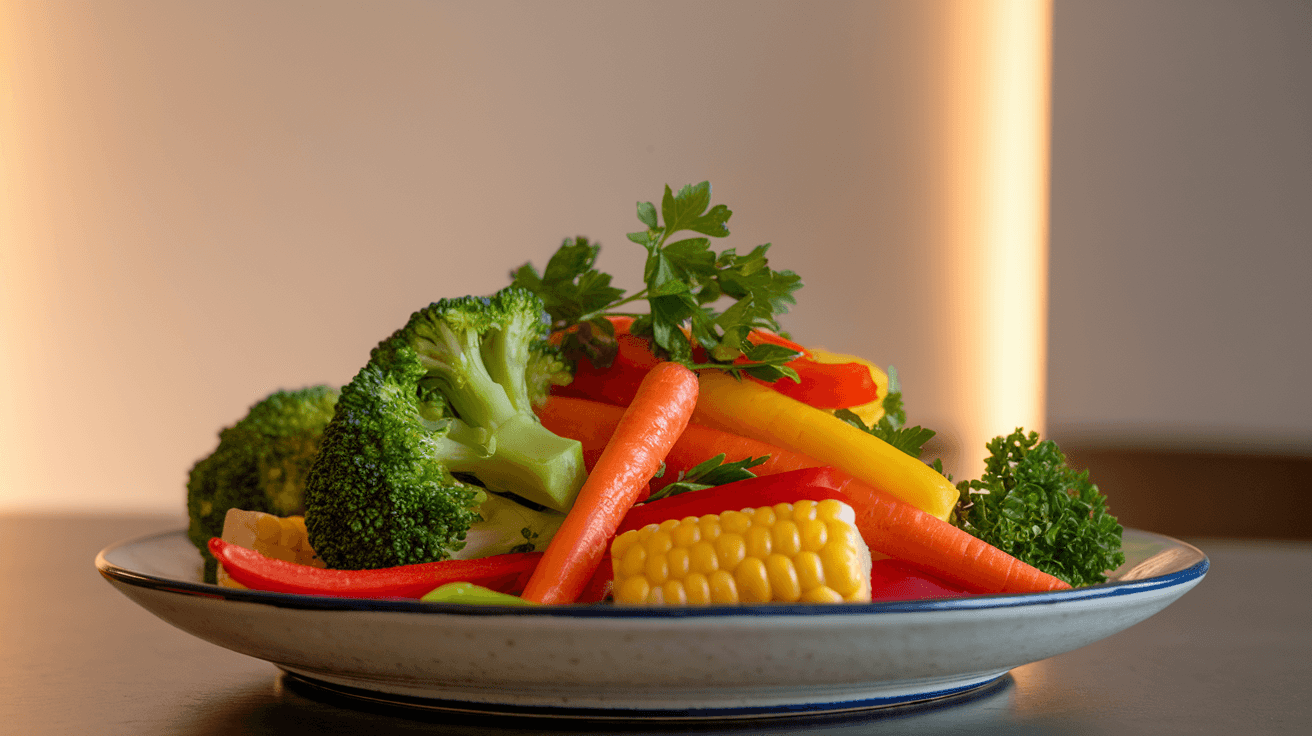Introduction
Wondering how long does it take to cook frozen vegetables? This article covers everything you need to know about preparing a quick, nutritious meal. Whether you’re a busy professional, a parent juggling multiple tasks, or just someone looking for a quick side dish, frozen vegetables offer versatility and ease of use. But how long does it actually take to cook them? This guide will walk you through various cooking methods, tips, and tricks to ensure perfectly cooked frozen vegetables every time.
From boiling to steaming, roasting, and microwaving, the cooking time can vary based on the method and the type of vegetable. In this article, we’ll explore each technique in detail, helping you achieve the ideal texture and flavor while preserving maximum nutrients.
Why Choose Frozen Vegetables?
Many people wonder how long does it take to cook frozen vegetables, but the answer depends on the method you use. Regardless of time, frozen vegetables are a staple in households worldwide for their convenience and nutrition. They are convenient, affordable, and surprisingly nutritious. Let’s explore why you should consider adding frozen vegetables to your meals:
Benefits of Frozen Vegetables
- Convenience: Frozen vegetables are pre-washed, pre-cut, and ready to use, saving you valuable prep time.
- Longer Shelf Life: Unlike fresh produce, frozen vegetables can be stored for months without spoiling, reducing food waste.
- Year-Round Availability: Seasonal vegetables are accessible all year round when frozen, allowing you to enjoy your favorites anytime.
Nutritional Value Comparison to Fresh Vegetables
One common misconception is that frozen vegetables are less nutritious than fresh ones. In reality, many frozen vegetables are flash-frozen at their peak ripeness, locking in essential nutrients. Research shows that:
- Frozen vegetables often retain more vitamins and minerals compared to fresh produce that may degrade during transport and storage.
- Cooking methods impact nutrition more than the freezing process itself.
In summary, frozen vegetables offer a balance of convenience, cost-effectiveness, and nutrition, making them an excellent addition to any meal plan.
Different Methods of Cooking Frozen Vegetables

Cooking frozen vegetables can be done in several ways, each offering a unique texture and flavor profile. Choosing the right method depends on your preferences and the dish you’re preparing. Here are some popular techniques:
Boiling Frozen Vegetables
Boiling is a quick and straightforward method, ideal for vegetables like peas, corn, or green beans. To boil:
- Bring a pot of water to a rolling boil.
- Add a pinch of salt for flavor enhancement.
- Drop the frozen vegetables into the boiling water and cook for 3–8 minutes, depending on the type of vegetable.
- Drain and serve immediately to avoid overcooking.
Steaming Frozen Vegetables
Steaming helps retain the color, texture, and nutrients of vegetables. Here’s how to steam frozen vegetables:
- Fill a pot with about 1–2 inches of water and bring it to a simmer.
- Place a steaming basket or colander over the pot and add the frozen vegetables.
- Cover and steam for 5–10 minutes, depending on the vegetable.
Roasting Frozen Vegetables
Roasting is perfect for achieving a caramelized, crispy texture. For best results:
- Preheat your oven to 425°F (220°C).
- Toss the frozen vegetables with olive oil, salt, and spices of your choice.
- Spread them evenly on a baking sheet.
- Roast for 15–25 minutes, stirring halfway through for even cooking.
Stir-Frying Frozen Vegetables
Stir-frying is a great way to create a quick and flavorful dish. To stir-fry:
- Heat a tablespoon of oil in a skillet or wok over medium-high heat.
- Add the frozen vegetables directly to the hot pan.
- Cook for 5–8 minutes, stirring frequently, until the vegetables are heated through and slightly browned.
Microwaving Frozen Vegetables
The microwave is the fastest method for cooking frozen vegetables. To microwave:
- Place the frozen vegetables in a microwave-safe dish.
- Add a tablespoon of water and cover with a lid or plastic wrap.
- Microwave on high for 3–6 minutes, stirring halfway through.
- Check for doneness and microwave further if needed.
Each method offers a unique way to enjoy your frozen vegetables, so experiment to find your favorite!
How Long Does It Take to Cook Frozen Vegetables: Determining Cooking Times

The cooking time varies, so understanding how long does it take to cook frozen vegetables will depend on factors like the type, method, and texture you prefer. Understanding these variables ensures perfectly cooked vegetables every time.
Factors Influencing Cooking Time
- Type of Vegetable: Leafy greens like spinach cook faster than root vegetables like carrots or potatoes.
- Cooking Method: Methods like microwaving or stir-frying are quicker, while roasting and steaming may take longer.
- Size of the Pieces: Smaller or diced vegetables cook faster compared to whole or larger pieces.
Importance of Vegetable Type
Different vegetables require different cooking times to achieve optimal texture and flavor. Here’s a quick guide:
| Vegetable | Cooking Time (Boiling/Steaming) | Cooking Time (Roasting) |
|---|---|---|
| Peas | 3–5 minutes | 15–20 minutes |
| Broccoli | 5–7 minutes | 20–25 minutes |
| Carrots | 6–10 minutes | 25–30 minutes |
| Spinach | 2–4 minutes | Not recommended |
Packaging Instructions
Always refer to the instructions on the packaging of your frozen vegetables. Manufacturers often provide specific cooking times tailored to the product, ensuring the best results.
Additionally, keep in mind that cooking times may vary based on your stove, microwave, or oven. Adjust as needed and check for doneness by tasting or using a fork to test texture.
Step-by-Step Guide for Cooking Frozen Vegetables
Cooking frozen vegetables doesn’t have to be complicated. Follow this step-by-step guide to prepare delicious and nutritious veggies every time, no matter the method you choose.
Step 1: Preparation
- Read the Label: Check the packaging for specific cooking instructions and serving suggestions.
- No Need to Thaw: Frozen vegetables can typically go straight from the freezer to the pot, pan, or oven.
- Measure the Quantity: Use the desired amount of vegetables and reseal the bag to prevent freezer burn.
Step 2: Choose the Right Cooking Method
Each method of cooking has its advantages. Consider your time, available equipment, and the flavor or texture you’re aiming for:
- Quick and Easy: Opt for boiling or microwaving if you’re short on time.
- Flavorful and Crispy: Choose roasting or stir-frying for enhanced taste and texture.
- Healthy and Simple: Steaming is a great way to retain nutrients.
Step 3: Timing for Different Vegetables
The cooking time varies depending on the type of vegetable and method. Here are some general guidelines:
- Boiling: 3–10 minutes depending on the vegetable.
- Steaming: 5–12 minutes, depending on the size and type.
- Microwaving: 3–6 minutes for most vegetables.
- Stir-Frying: 5–8 minutes with continuous stirring.
- Roasting: 15–30 minutes at 425°F (220°C), stirring halfway through.
Step 4: Check for Doneness
Once the vegetables have cooked for the recommended time, test for doneness by:
- Inserting a fork or knife to check tenderness.
- Tasting to ensure the texture is to your liking.
Step 5: Serve and Enjoy
After cooking, season the vegetables with salt, pepper, or herbs for added flavor. Serve as a side dish, mix into recipes, or enjoy as a healthy snack!
By following these steps, you’ll ensure that your frozen vegetables are cooked perfectly every time, no matter the occasion.
Common Mistakes to Avoid
Even though cooking frozen vegetables is straightforward, some common mistakes can negatively impact their flavor, texture, and nutritional value. Avoid these pitfalls to achieve the best results:
Overcooking
Overcooking frozen vegetables can lead to a mushy texture and loss of flavor. To avoid this:
- Stick to recommended cooking times.
- Check for doneness frequently, especially when trying a new cooking method.
- Remove the vegetables from heat as soon as they are tender-crisp.
Skipping Seasoning
Frozen vegetables are often blander than fresh produce and benefit greatly from seasoning. Enhance their flavor by:
- Adding salt, pepper, garlic, or herbs during or after cooking.
- Using sauces like soy sauce, balsamic glaze, or melted butter for added depth.
- Experimenting with spices like paprika, cumin, or chili flakes for extra kick.
Using the Wrong Cooking Method
Not all cooking methods are suitable for every type of vegetable. Avoid these mistakes:
- Roasting leafy vegetables: Spinach or kale can dry out quickly in the oven.
- Boiling delicate vegetables: Peas and beans might lose their vibrant color and become too soft.
- Microwaving starchy vegetables: Potatoes or sweet potatoes may cook unevenly.
Failing to Drain Properly
Excess water can make cooked vegetables soggy. To prevent this:
- Use a colander to thoroughly drain boiled or steamed vegetables.
- Pat them dry with a paper towel before stir-frying or roasting.
Ignoring the Packaging Instructions
Frozen vegetable packages often include specific cooking times and recommendations. Ignoring these guidelines can lead to over- or under-cooking. Always review the instructions before starting.
By avoiding these common mistakes, you’ll ensure that your frozen vegetables turn out flavorful, perfectly cooked, and ready to elevate any meal.
FAQs About Cooking Frozen Vegetables
Cooking frozen vegetables may seem simple, but you might still have some questions. Here are answers to common queries to help you get the best results every time:
1. Do I need to thaw frozen vegetables before cooking?
No, most frozen vegetables can be cooked directly from frozen. Thawing is unnecessary and can lead to mushy texture for certain vegetables. However, if you’re adding them to a stir-fry or baking dish, a quick thaw may help ensure even cooking.
2. How do I prevent frozen vegetables from becoming soggy?
To avoid sogginess:
- Cook at high heat when roasting or stir-frying.
- Avoid overcooking by following recommended cooking times.
- Drain or pat dry boiled or steamed vegetables before serving.
3. Can I use frozen vegetables in soups and stews?
Absolutely! Frozen vegetables are a great addition to soups and stews. Add them during the last 10–15 minutes of cooking to prevent overcooking and preserve their texture.
4. What is the best way to season frozen vegetables?
Season frozen vegetables with:
- Classic options like salt, pepper, and olive oil.
- Fresh or dried herbs like basil, oregano, or thyme.
- Flavor enhancers such as garlic, onion powder, or soy sauce.
5. Are frozen vegetables as healthy as fresh ones?
Yes! Frozen vegetables are often just as healthy, if not more so, than fresh ones because they are flash-frozen at their peak ripeness, preserving nutrients. The key is to avoid overcooking, which can diminish their nutritional value.
6. Can I refreeze unused frozen vegetables?
It’s best not to refreeze thawed vegetables as this can affect their texture and quality. Instead, store leftovers in the fridge and use them within 2–3 days.
These FAQs address the most common concerns about cooking frozen vegetables, ensuring you have the knowledge to make delicious meals every time.
Conclusion

If you’ve ever wondered how long does it take to cook frozen vegetables, this guide offers all the answers you need for any occasion. By understanding the different cooking methods, appropriate timing, and common mistakes to avoid, you can ensure that your vegetables turn out flavorful and perfectly cooked every time.
Whether you’re boiling, steaming, roasting, stir-frying, or microwaving, each method offers its own unique benefits and opportunities to experiment with flavors and textures. Remember to season your vegetables well and choose the right cooking method based on the type of vegetable and the dish you’re preparing.
Frozen vegetables are not only economical but also packed with nutrients, making them an excellent choice for busy schedules or quick meal prep. By incorporating them into soups, stews, side dishes, or even main courses, you can enjoy a variety of healthy and delicious meals with minimal effort.
So, the next time you’re in a pinch or looking to whip up something wholesome and fast, reach for frozen vegetables. With this guide in hand, you’ll always know how long it takes to cook them to perfection. Happy cooking!

